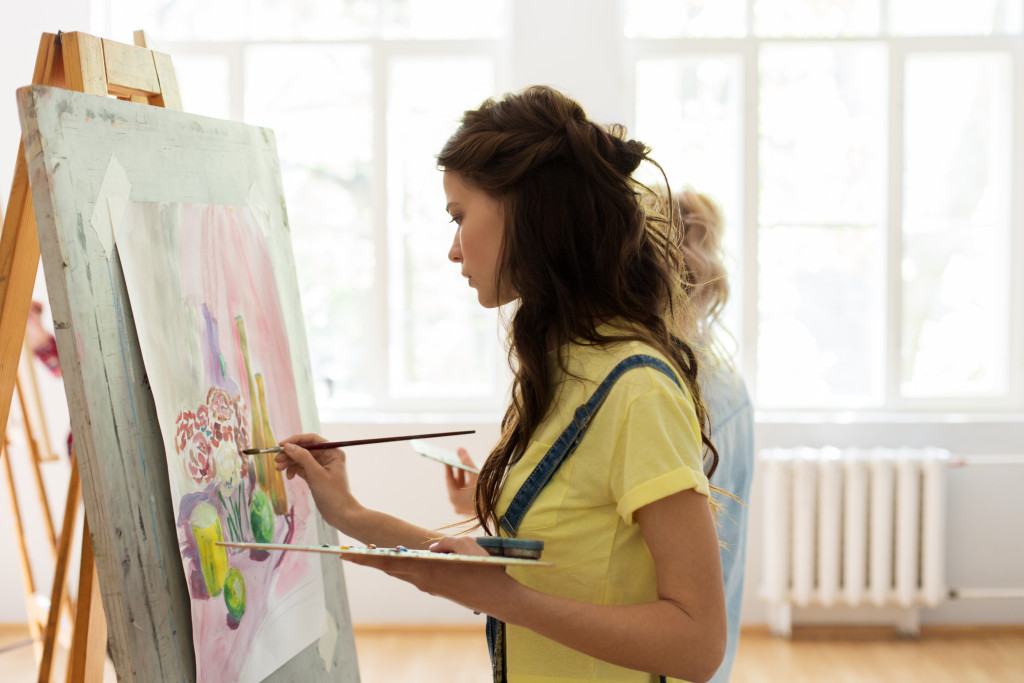- Start with basic art supplies such as crayons, markers, colored pencils and sketchbooks for them to explore their creativity.
- Take enriching trips to art museums and galleries to learn about art history and the stories behind famous artworks.
- Engage in craft projects with their parents to develop fine motor skills, explore imagination and gain creative expression.
- Incorporate art into everyday activities like decorating greeting cards or painting t-shirts, making it a natural part of their routine.
- Encourage music lessons to introduce them to melodies and rhythms and help develop essential skills like concentration.
Introducing art to your children is a wonderful way to foster their creativity, imagination, and self-expression. Art can help develop their fine motor skills, boost their cognitive abilities, and provide them with a means of communication and self-discovery. Whether your child shows a natural inclination towards art or you want to expose them to new forms of artistic expression, there are various ways to incorporate art into their lives. This guide will explore five effective ways to introduce art to your kids and help them embark on a colorful and creative journey.
1. Start with Basic Art Supplies
The first step in introducing art to your kids is to provide them with the necessary tools and materials. Start with basic art supplies like crayons, markers, colored pencils, and sketchbooks. These simple materials allow your children to explore their creativity and experiment with different colors and textures. Encourage them to draw, color, and create freely without pressure or expectations. Provide them with a designated art space where they can let their imaginations run wild and express themselves through their artwork.
To take it further, consider introducing different art mediums such as watercolors, acrylic paints, or clay. Experimenting with different materials will help your child discover their preferences and expand their artistic horizons. Engage in art activities together, whether drawing side by side or exploring different art techniques. Starting with basic art supplies and engaging in art activities together lays a strong foundation for your child’s artistic journey.
2. Visit Art Museums and Galleries

Take enriching trips to art museums and galleries to expose your kids to various artistic styles and masterpieces. Many museums offer family-friendly programs and interactive exhibits specifically designed for children. These experiences expose your kids to different art forms and teach them about art history and the stories behind famous artworks.
Here are some art museums and galleries to visit:
The National Gallery of Art, Washington DC
The National Gallery of Art in Washington DC houses some of the world’s greatest works of art from all eras and schools. From ancient Egyptian artifacts to Renaissance paintings, this museum is a great place for your little ones to explore and learn about various art forms. Several exhibitions are tailored to kids that feature interactive activities and games so they can have fun while learning about different periods in art history.
Museum of Modern Art, New York City
A trip to the Museum of Modern Art (MoMA) is a must for any budding artist! Showcase contemporary pieces from world-renowned artists like Pollock, Warhol, Picasso, and more. Take the kids on a guided tour to learn about these works and how they were made. MoMA also offers fun, hands-on activities like art workshops and interactive installations for the little ones. They can even create their own masterpiece inspired by what they’ve seen!
The Art Institute of Chicago
The Art Institute of Chicago has an impressive collection of modern and classic paintings, sculptures, and photography. Join one of their family programs or take a self-guided tour around the exhibits with your children. There are also interactive activities tailored to young artists that allow them to explore new ways of seeing and creating art in different mediums.
LACMA, Los Angeles
Take your kids on a journey through the art world at the Los Angeles County Museum of Art (LACMA). This museum offers various interactive activities for all ages, such as scavenger hunts and sketching classes. They also host family-friendly events like artist talks, film screenings, and performances. These experiences allow your little ones to explore new ways of understanding and appreciating art.
3. Engage in Craft Projects

Craft projects are a fun and hands-on way to introduce art to your kids. Set aside dedicated craft time where you can work on projects together. Choose age-appropriate crafts that align with your child’s interests and abilities. It could be anything from paper mache, collage, origami, or simple sewing projects.
Provide them with construction paper, glue, scissors, buttons, yarn, and fabric scraps. Encourage them to explore their creativity and imagination while creating their own unique masterpieces. Crafts not only develop their fine motor skills but also allow them to experiment with different textures, colors, and shapes. Display their finished crafts proudly in your home or create a special gallery wall to showcase their artistic creations.
4. Incorporate Art into Everyday Activities
Art doesn’t have to be limited to specific art sessions or projects. Find ways to incorporate art into your everyday activities. For example, encourage your child to decorate their own greeting cards for birthdays or holidays. Have them design and paint their own t-shirts or tote bags. Encourage them to illustrate their favorite stories or create their own comic books. These activities blend art with daily life, making it a natural and enjoyable part of their routine.
Involve your child in household tasks that require creativity, such as decorating a cake or arranging flowers. Allow them to make decisions and express their artistic flair. Integrating art into everyday activities creates a seamless connection between their artistic endeavors and their daily lives.
5. Encourage Music Lessons
Music is a form of art that offers numerous benefits for children. Consider enrolling your child in engaging kids’ music lessons to introduce them to melodies, rhythms, and musical expression. These music lessons will help your child develop essential skills such as concentration, coordination, and fine motor development. Furthermore, they will also help them become more creative and expressive in their approach to art.
Research different music schools or teachers in your area and choose an instrument or style of music that resonates with your child’s interests. Encourage them to practice regularly and provide opportunities to perform in a small recital at home or at local community events. By embracing music as part of their artistic journey, you broaden their artistic skills and provide them with an avenue for self-expression and personal growth.
To Wrap It Up
Introducing art to your kids is a rewarding and enriching experience. By starting with basic art supplies, visiting art museums and galleries, engaging in craft projects, incorporating art into everyday activities, and encouraging music lessons, you open the doors to a world of creativity and self-expression for your children. Remember to provide a nurturing and supportive environment where they can explore, experiment, and create without judgment. By embracing art, you empower your kids to express themselves, build confidence, and develop lifelong skills that will enrich their lives in countless ways. So, unleash their inner artist and watch their creativity soar!













